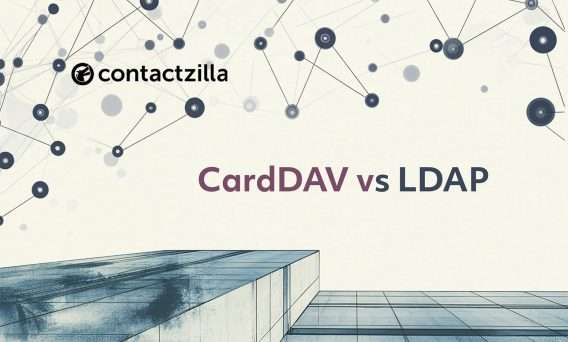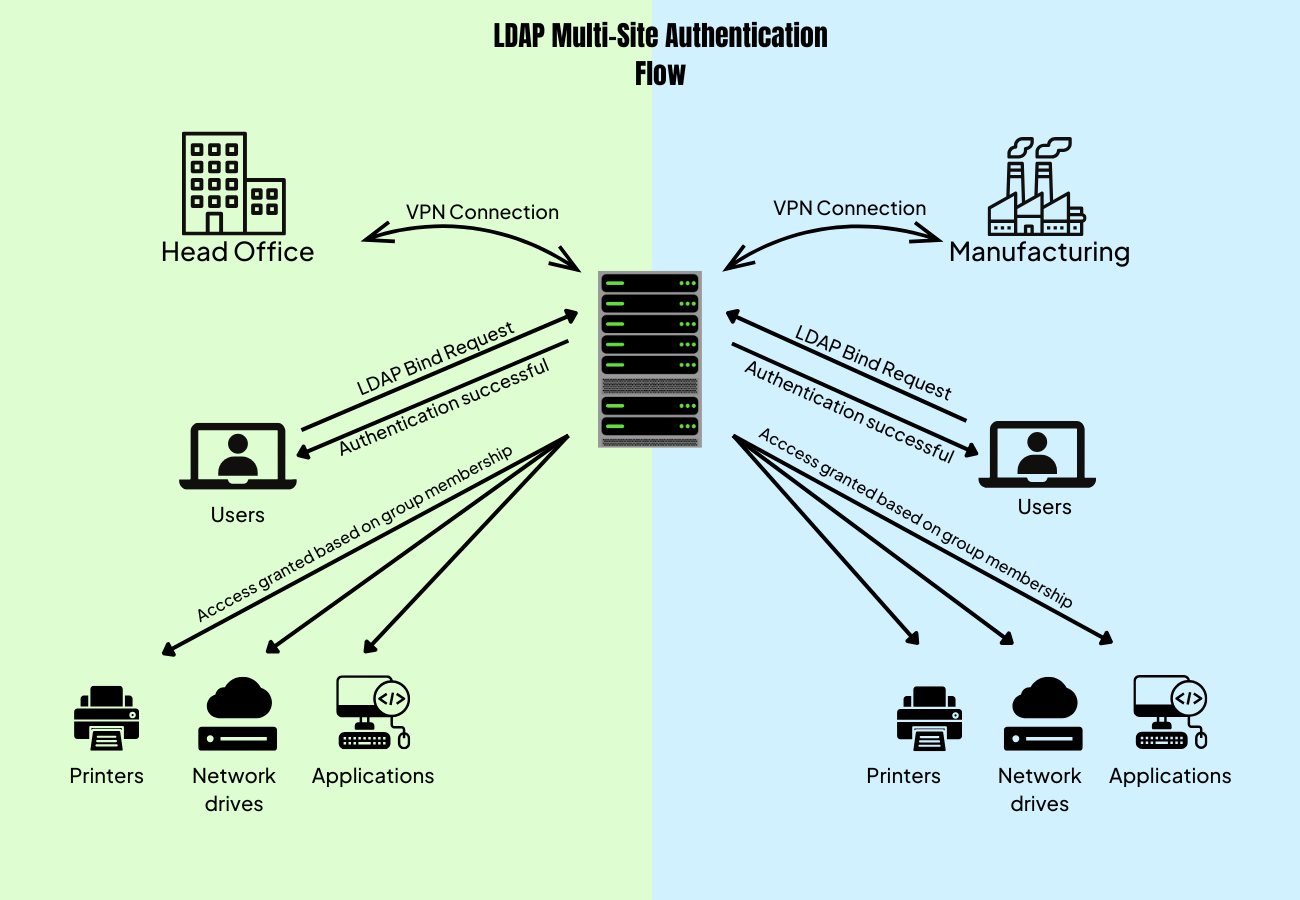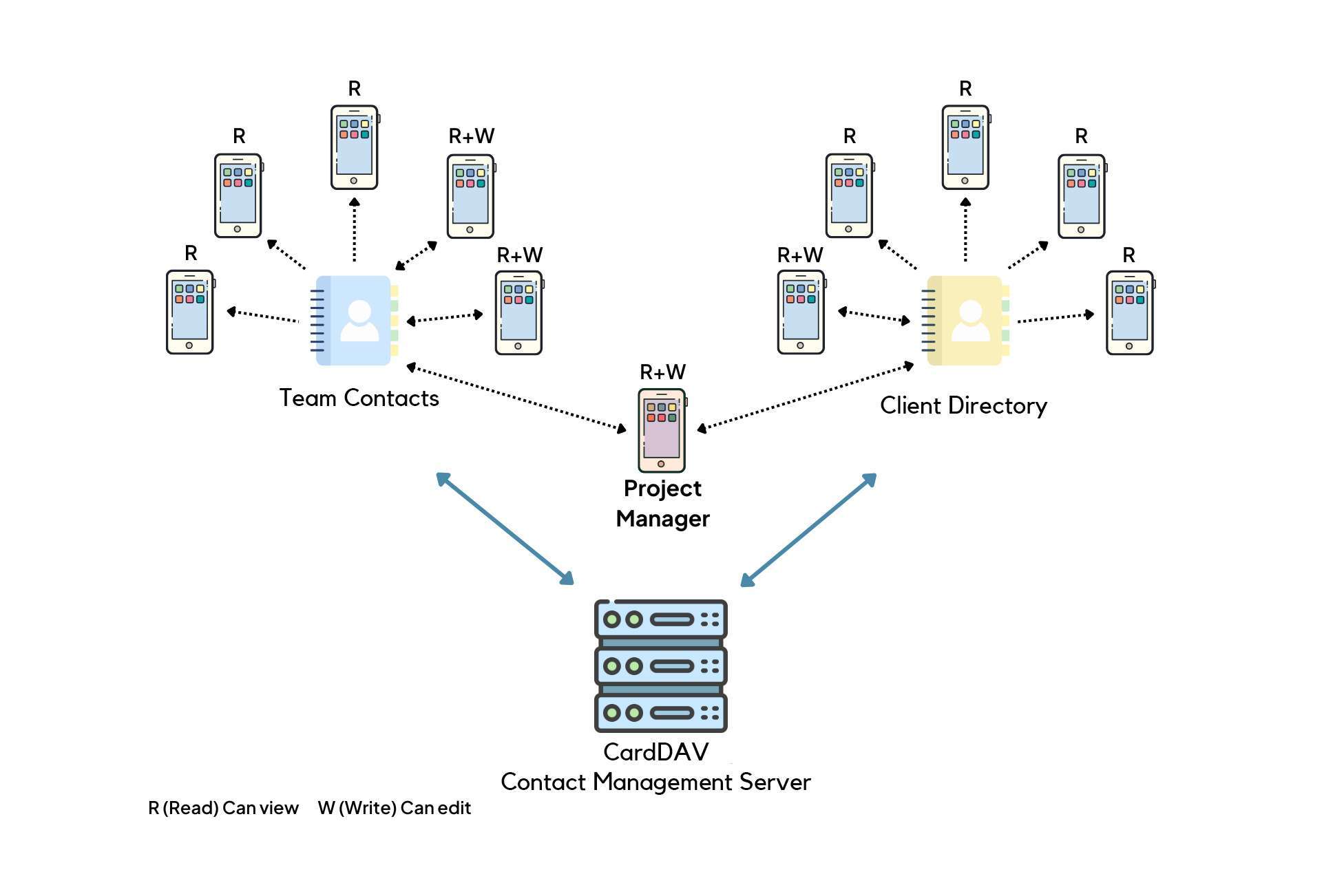CardDAV vs LDAP: Building a Complete Contact Infrastructure

Introduction
In enterprise environments, LDAP (Lightweight Directory Access Protocol) and CardDAV frequently appear in technical discussions, yet their distinct purposes are often misunderstood. While they may seem like competing technologies, they serve distinct yet complementary purposes.
Both are open standards, with LDAP providing comprehensive directory services and authentication management across enterprise systems, while CardDAV specifically handles contact synchronization across platforms and devices.
First lets look at each protocol in more detail.
Understanding LDAP
LDAP operates as a directory service protocol, managing authentication and organizational data, including usernames, passwords and permissions through a hierarchical structure. Its architecture emphasizes read operations over writes, making it ideal for enterprise authentication and authorization tasks.
| Component | What It Does |
| Directory Information Tree (DIT) | Creates a hierarchical structure for storing organizational data, like folders within folders |
| Directory Server | Acts as the security guard – checking credentials and managing who can access what. |
| LDAP Clients | Applications that request information from LDAP (e.g., Thunderbird or Mac mail checking email credentials, Google Workspace authentication, VPN verifying access rights) |
| Schema | Defines rules for how data must be structured – like a strict template for information |
| Single Sign-On | Lets users access multiple systems with one login |
| Role-Based Access | Automatically grants access based on job roles (e.g., HR staff can view personnel files) |
| Resource Mapping | Connects users to their needed resources (like network drives and printers) |
| Central Authentication | Provides one source of truth for all user permissions |
LDAP Server – Real world example
A large manufacturing company with 5,000 employees across two locations demonstrates LDAP’s capabilities in practice.

When Sarah from Accounting starts work, the LDAP server springs into action:
- Her login triggers an LDAP bind request to the directory server, securely transmitting her encrypted password
- The server verifies her Distinguished Name (DN: uid=sarah,ou=accounting,dc=company,dc=com)
- LDAP checks her group memberships (accounting, finance_reports, AP_team)
- Based on these groups, she automatically gains access to:
- Accounting software
- Financial reporting systems
- Department network drives
- Relevant printers
Later, when Sarah transfers to Finance:
- IT updates her organizational unit in LDAP
- Her access rights automatically update across all systems
- She instantly gains Finance department permissions
- Her old Accounting permissions are removed
This automatic propagation of changes across systems demonstrates why LDAP is valuable for large organizations – one change updates permissions everywhere.
LDAP is not Active Directory – Clearing up confusion
LDAP and Active Directory are often mixed up. LDAP is a protocol, while Active Directory is Microsoft’s implementation using this protocol. Other implementations include OpenLDAP, Apple Open Directory, and Samba v4. Organizations can choose any directory service supporting LDAP based on their requirements.
What about Linux?
Linux environments have several robust LDAP implementations. OpenLDAP provides a flexible open-source solution, while Red Hat’s FreeIPA combines LDAP with additional services like Kerberos and DNS, making it particularly suitable for Red Hat-based systems. Both solutions provide the same core LDAP functionality as Active Directory, letting organizations choose based on their technical requirements.
Understanding CardDAV
CardDAV builds upon WebDAV (Web Distributed Authoring and Versioning), which provides the foundation for web-based content management. While WebDAV handles general file operations, CardDAV specifically extends this functionality for contact management.
| Protocol | Purpose |
| WebDAV | Basic web file operations and resource management |
| CardDAV | Contact-specific synchronization and sharing |
| CalDAV | Calendar sync (often implemented alongside CardDAV) |
CardDAV and CalDAV often work together in enterprise environments, as both protocols share similar principles for data synchronization. While CardDAV handles contact management, CalDAV manages calendar data, and organizations frequently implement both to create a complete communication infrastructure. Both protocols build upon WebDAV’s foundation, providing specialized functionality for their respective data types.
CardDAV specializes in contact sync, using the standardized vCard format to ensure compatibility across platforms. From small design studios to enterprises managing hundreds of iOS and android devices, CardDAV handles both shared and private address books while maintaining real-time updates across authorized devices.
Share read-only contact lists across 100’s of devices
 14 DAY FREE TRIAL
14 DAY FREE TRIAL  NO CREDIT CARD REQUIRED
NO CREDIT CARD REQUIRED

Key Features of CardDAV
- Simultaneous management of shared and private contacts
- standardized vCard format for universal compatibility
- Granular permission controls
- Instant sync across devices
- Native integration with mobile devices contacts app and email clients on mac and pc
- Seamless appearance in phone contact apps
- Integration with popular platforms including Google Contacts and iCloud
One of the great things about CardDAV is its invisibility to end users – contacts simply appear in native phone apps and email clients, making complex synchronization feel effortless.
Tip 💡 : Need to share contacts across your team? Learn how to set up and manage shared contact lists for your organization in our guide.
Combining LDAP with CardDAV
As organizations scale, they face increasingly sophisticated integration challenges. Consider a manufacturing company where marketing uses Mozilla Thunderbird for email while sales insists on Outlook. The calendar system needs to sync with Google Workspace, which field workers access on their phones. Meanwhile, HR maintains a separate contact database for internal use, and the service team needs real-time access to customer contact lists on their iPhones.
While CardDAV excels at contact synchronization, it wasn’t designed to handle enterprise-level authentication and access control. Organizations need a way to manage who can access what resources across all these different systems.
This is where LDAP and CardDAV complement each other perfectly. CardDAV manages what contacts people see while LDAP controls who can see them.
A typical enterprise implementation would:
- LDAP server authenticates users when they access the CardDAV server address
- The CardDAV server stores and manages all contact info
- Authenticated users can then sync contacts across all their devices
This approach combines LDAP’s robust authentication capabilities with CardDAV’s powerful contact synchronization features, creating a secure and efficient contact management system.
Tip 💡 : Want to master contact synchronization across your devices? Discover how CardDAV servers can keep your contacts in sync in our comprehensive guide to contact synchronization.
Using LDAP as a Backend for CardDAV
In some environments, administrators want to store and manage contact data in a central LDAP directory – perhaps because it also handles user logins and group memberships – but still make that data accessible to modern devices that prefer CardDAV. By combining LDAP’s directory capabilities with a CardDAV service, organizations ensure:
Single Source of Contact Data
Contacts remain in one LDAP directory, so any edits or updates made by admins are automatically reflected in the CardDAV service.
Modern Sync Experience
End users benefit from real-time synchronization on mobile phones and desktop email clients that support CardDAV. They don’t have to connect to an LDAP server manually or worry about query limitations.
Authentication Consistency
Since authentication is controlled by LDAP, user access to CardDAV address books can be granted or revoked using standard LDAP group memberships or roles.
Challenges and Workarounds
- Many CardDAV servers only use LDAP for login credentials, rather than actual data storage.
- Tools like SOGo or custom combinations (for example, an LDAP-to-CardDAV gateway) can map LDAP fields into CardDAV’s vCard format, but might require extra configuration.
- Some organizations script routine exports from LDAP into a CardDAV server or vice versa, ensuring both systems mirror their relevant fields accurately.
This approach can be particularly appealing for companies that want to preserve an existing LDAP backend for security and overhead reasons, yet still give employees the seamless contact synchronization that CardDAV provides. In doing so, they bridge the gap between older enterprise directory protocols and modern contact syncing requirements.
Conclusion
The distinction between LDAP and CardDAV matters because they address critical needs in modern IT infrastructure: secure identity management and seamless contact synchronization. Organizations that understand these protocols can build systems that grow with them, while keeping things simple for the people who use them every day.
CardDav vs LDAP – Frequently Asked Questions
What Makes CardDAV Different from LDAP?
CardDAV specializes in contact synchronization across devices using the vCard format, while LDAP manages authentication and directory services. CardDAV focuses on keeping contact information synced between phones and computers, while LDAP controls who can access resources in an organization.
In ldap what does DN stand for at the beginning of the entry
DN stands for Distinguished Name in LDAP. It uniquely identifies an entry and its position in the directory hierarchy, similar to a file path in a filesystem. A DN consists of attribute-value pairs separated by commas, describing the entry’s location from specific to broad identifiers
How Do CardDAV and LDAP Work in Modern Communication Systems?
In modern communication systems, CardDAV and LDAP work together but serve different purposes. CardDAV synchronizes contacts across devices using vCard format, while LDAP manages user authentication and access control. Together, they enable secure contact sharing and directory services in enterprise environments
Can LDAP Be Used Instead of CardDAV for Contact Synchronization?
While LDAP can manage contact information, it’s not ideal for contact synchronization across devices. LDAP excels at authentication and directory services, while CardDAV is specifically designed for contact synchronization using the vCard format, making it better suited for modern device synchronization needs.